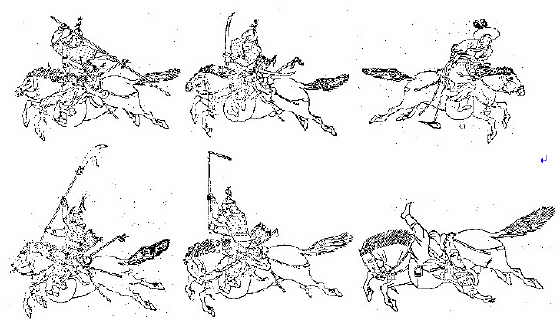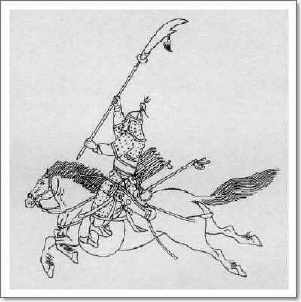The thing about swinging polearms from horseback, is that the force of the motion, weight of the weapon itself, and resulting impact, all contribute to a very real danger of either the rider falling off from the saddle, or the horse stumbling to its side. As such, the couched lance methods which surfaced between 11th - 12th century, is by all means a significant development in regards to mounted charge tactics in the history of cavalry. The stirrup, firm saddles, and couching all contributed to a very stable method of attack where the axis of the attack is in near alignment with the momentum of the rider.
Before couched lances, three methods of horseback spears were prevalent - the overhand, underhand, and twohanded methods.
-A picture depicting the overhand, couched, and underhand spearing techniques-
The overhand method is directly derived from foot spear/javelin throwing, and a very preferred method in the light cavalries of classical ages armed with short and light spears which could be thrown on horseback. Like the motion suggests, it was primarily for throwing the spears, and allowed for quick jabs and thrusts against usually unarmoured infantry.
The underhand method was used alongside the overhand method, but far less frequently, and was usually fit for longer, heavier spears in the age where couching was not a widely used method. The serious drawback of this technique was that due to the single handed grip, there was a danger of injury to the wrists if the rider thrust too deeply with his spear - in which case the spear couldn't be prodded out as the rider passed by, and if he failed to release in time, would seriously twist his wrists.
- A Koguryo heavy cavalryman, using the two-handed technique of spearing -
Then there is the two-handed method.
This method was widely spread in the entirety of the Asian continent, ranging from Middle East, to the Far East. The two pictures above show a 5th - 6th century heavy cavalryman of the Koguryo kingdom, using a classic two-handed method, which would later evolve into horseback polearms used in the Far East, after the modes of weapons were re-established by the armies of the Chinese Song dynasty(960-1279).
The two handed method offered a firm grip on the weapon, which allowed much more faster, stronger range of motion on horseback which included strikes and swings as well as the typical thrusting. However, the drawback was that since both hands held the weapon, the horse had to be steered and controlled entirely by the riders legs alone, which took high degree of skill in horsemanship.
As more powerful cavalry forces began to appear in the Far East (due to the increase of major incursions and invasions coming from northern tribes), in time, between the periods of the Song dynasty, and upto Yuan and Ming dynasties, the cavalry spears were replaced with longer, heavier weapons which resembled a glaive.
These types of horseback polearms, usually referred to as a 'moon sword', are immortalized with the icons the ancient general Guan Yu, a historical figure deified after his death, and became to be worshipped as a god of war and righteousness in the Far East.
- Popular depiction of Guan Yu on horseback, with his 'Blue Dragon Moon Sword' -
However, it is ironic, since during the late Han dynasty, the weapons of cavalry were still plain swords and short spears. As mentioned, it is only after the 12th-13th century these horseback polearms began to appear in the Far East.
There is an excellent illustrated record concerning the use of these long, heavy horseback weapons, in the
<Muyedobotongji> (1790), a Chosun dynasty illustrations on military arts, created for training purposes. In volume2 is a chapter devoted to "Horseback Moon Swords", and in volume4, "Horseback Heavy Flail".
- From the top left: horseback spearmanship, horseback dual swords, polo, horseback moon swords, horseback flail, and horseback acrobatics -
There is also a 3D-rendered recreation of the 24 basic test categories required to pass to become a military officer in the Chosun army, among which 6 of them are cavalry tests. Among them is the use of heavy flails and moon swords on horseback:
- Close up of the use of the horseback moonsword -
Horseback Moon Swords (http://yjc.culturecontent.com/sub_03_02_b.asp?code=21)
Horseback Heavy Flail (http://yjc.culturecontent.com/sub_03_02_b.asp?code=22)
The videos are short, since they've only recreated what is directly illustrated by the <Muyedobotongji>, but it should be sufficient to see that swinging stuff from horseback required a short, fast, and precise swings, rather than a long and powerful swing as one might think. <Muyedobotongji> also mentions horseback polearms must be trained continuously to get a feel of how different weapons may effect the horse and the rider, and recommends a training of 3 different types of moon swords according to length and weight.
ps) Unfortunately, didn't have the time or resources to look into contemporary Chinese, or Japanese scriptures.
















